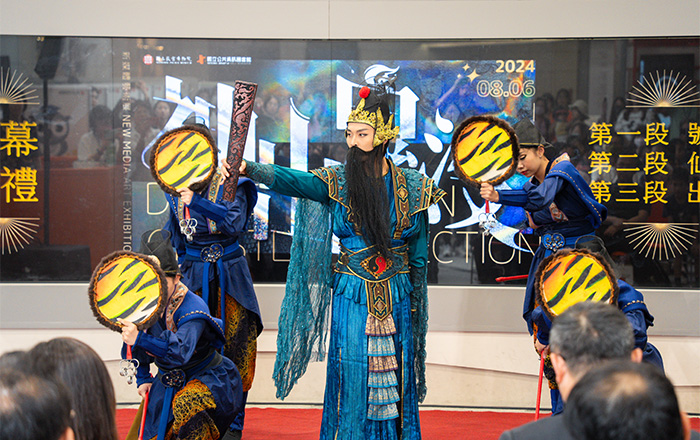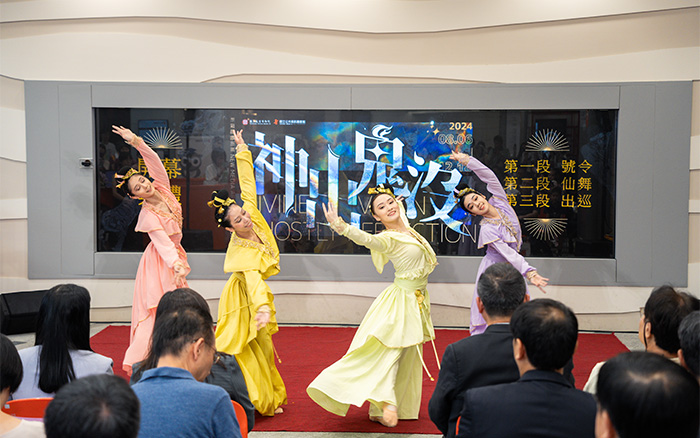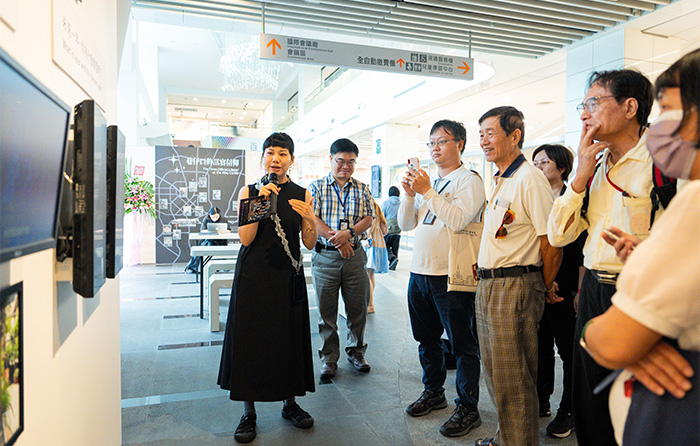The National Library of Public Information, in collaboration with the National Palace Museum, has organized a unique exhibition entitled “The Ghosts and the Devils - A New Media Art Exhibition”.
The National Treasure painting “The Three Taoist Officials Making an Inspection Tour” was re-interpreted with AI technology tools, combining the imagination of the ancients with the creativity of the modern people, resulting in an astonishing exhibition.
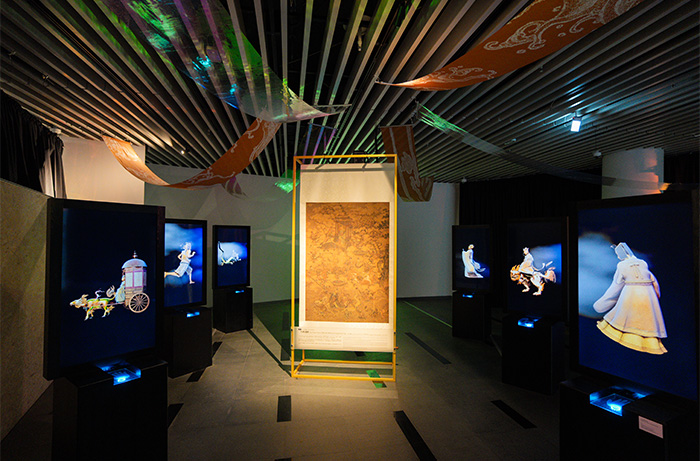
July 1 of the lunar calendar is the day when the door to the ghosts opens wide, and good brothers come from the underworld to the human world for a whole month. People in the Yang world treat them to incense, snacks and food, and organize Pujas in response to the arrival of the ghost beings. According to Buddhism, July is the “Month of Repayment of Gratitude” and “Month of Filial Piety,” and it is a time when people pray to make good karmic connections through the return of merit.
The National Library of Public Information (NLPI) is responding to this special month by organizing a unique exhibition in collaboration with the National Palace Museum (NPM) and National Formosa University.
Beginning August 6 and continuing through December 18 at the NLPI's 1st Floor Arts Gallery, visitors will be able to view “The Three Taoist Officials Making an Inspection Tour” from the NPM's collection depicting the gods of heaven, earth, and water, The exhibition will stimulate the imagination of the public.
At the same time, NLPI also introduces the temples of the Three Taoist Officials cult in the 5-kilometer radius of NLPI, where the public can make a pilgrimage according to the map, thus experiencing a different kind of art and culture tour from the ordinary ones.
The only dynamic performance in the palace collection
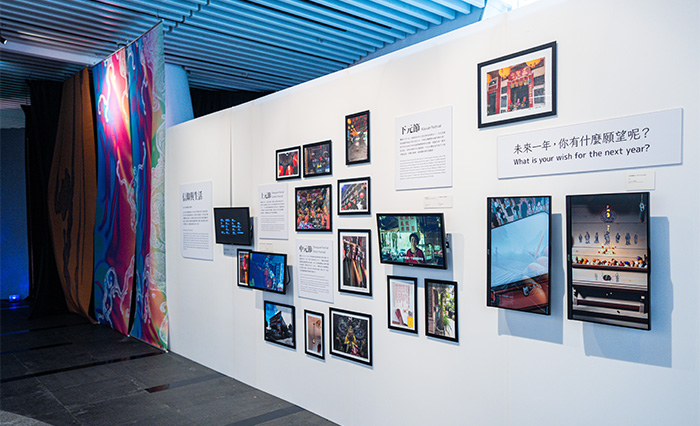
The curatorial team responsible for the design and planning of the event said that the pictures of the San guan in collections around the world are usually pictures of people sitting upright in temples, but the only one that combines the three realms into one picture with dynamic expression is the one in the collection of the Forbidden City, which shows its preciousness and special features.
In fact, the belief in the three gods is very common in Taiwan, and they are the heavenly, earthly and water officials second only to the Jade Emperor in Taoist beliefs. In Taiwan, it is common to see temples dedicated to the “Three Realms of the Lord”, “Three Realms of the Grandfather”, or the “Three Realms of the Great Emperor”, all of them are aliases of the three gods, which are rumored to be responsible for evaluating the merits of the beings in the heavenly realm, earthly realm, and water realm respectively, and to be able to bestow blessings, eliminate disasters, and relieve misfortunes.
 The curatorial team then explained in detail that the painting is divided into three layers, namely the upper, middle and lower layers, depicting the patrol teams of the San guan in the Heavenly Realm, the Earthly Realm and the Water Realm.
The curatorial team then explained in detail that the painting is divided into three layers, namely the upper, middle and lower layers, depicting the patrol teams of the San guan in the Heavenly Realm, the Earthly Realm and the Water Realm.
The composition of the three teams appears to be similar, with examiners leading the way, examiners holding books and soldiers carrying flags, but there are also unique features in each sector, such as an immortal with a third eye growing out of his forehead in the heavenly realm, amusing ghosts on the earthly realm, and monsters and spirits in the watery realm in the guise of fishes, prawns, frogs, and clamshells, fully demonstrating the different forms of living beings in the heavenly, earthly, and watery realms, and the artist's rich imagination in the realms of immortals and spirits. The artist's rich imagination of gods, fairies and ghosts is demonstrated.
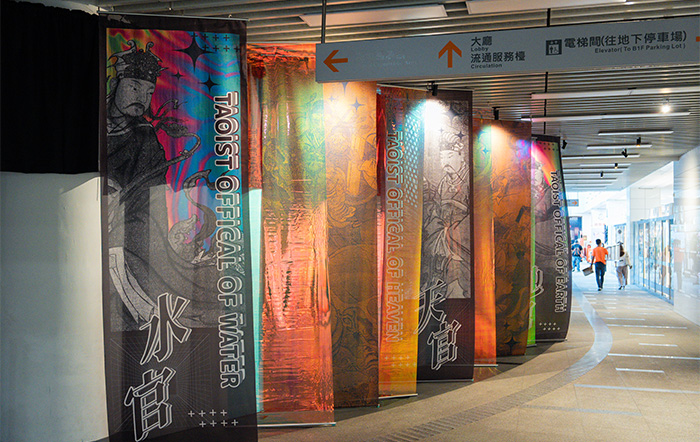
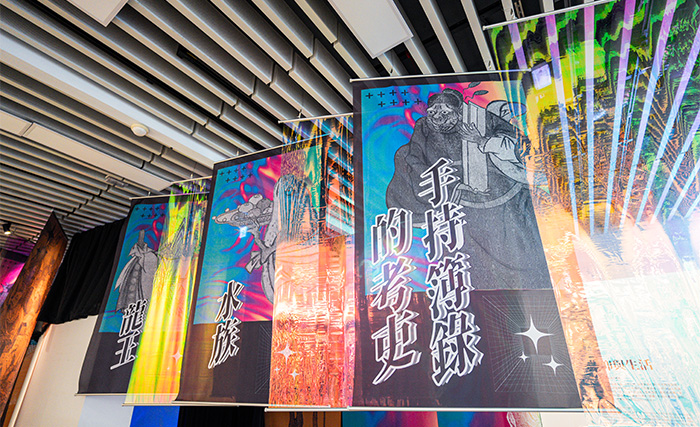
According to research, this painting may have been used as an altarpiece for Taoist ceremonies in the palace. Scholars have compared the literature of Taoist classics and their painting techniques, and hypothesized that this painting was produced in the Yuan or Ming Dynasty, which shows that the ancients had a rich imagination.
What makes this exhibition different from the previous ones is the introduction of AI technology and the visualization of images of gods, ghosts, spirits and monsters, in the hope that it can stimulate the imagination of the visitors to develop their own creative worlds through participation in the on-site DIY learning area, and this is the main purpose of NPM's planning for this exhibition.
Combined with AI technology to stimulate the imagination
The extended DIY experience of the exhibition will start with “The Three Taoist Officials Making an Inspection Tour” and combine it with new media art, inviting the audience to extend the meaning of the painting from the mood, scenes and details in the painting, and through the demonstration of scriptures and Taiwanese festivals and rituals, it will lead the audience to think about the connection between the reality of their daily lives and the unknown world, and to imagine the connection between the real and the unknown world, and to feel their own latent fear of the unknown world.
The exhibition also invites the audience to utilize modern AI tools to combine their personal creativity with public wisdom, and to see what possibilities they can bring to the unknown and to their daily lives. For example, in the interactive installation “Beyond Human Beings”, there will be six rotating 3D models of Heavenly Officials, Earthly Officials, Water Officials, Heavenly Examiners, Ghost Pawns, and Dragon Kings, and the audience will press their palms against the illuminated area in front of the screen, the 3D models will stop rotating, and a vaporization effect will appear, and the corresponding poems and stickers will appear, through which the audience can learn about the worldview of the characters of the artwork.
It is a ritualistic interactive installation that inspires the audience to imagine the existence of ghosts and spirits.
The curatorial team is particularly attentive to how to stimulate the imagination of the viewer, for example, what should a fish look like if it has become a spirit? Is it a man, a fish, or a monster? All these are naturally stimulated through the process of viewing the exhibition, and the imagination of the viewers will be different from each other.
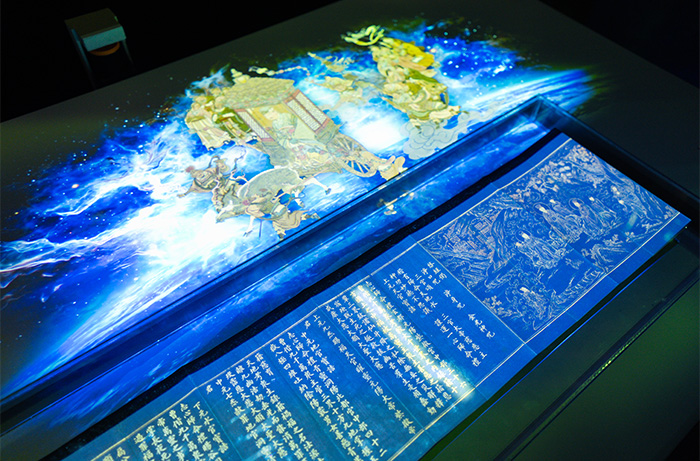
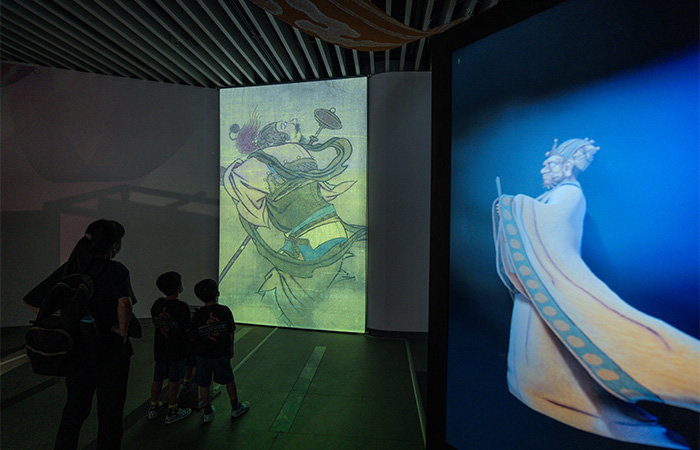
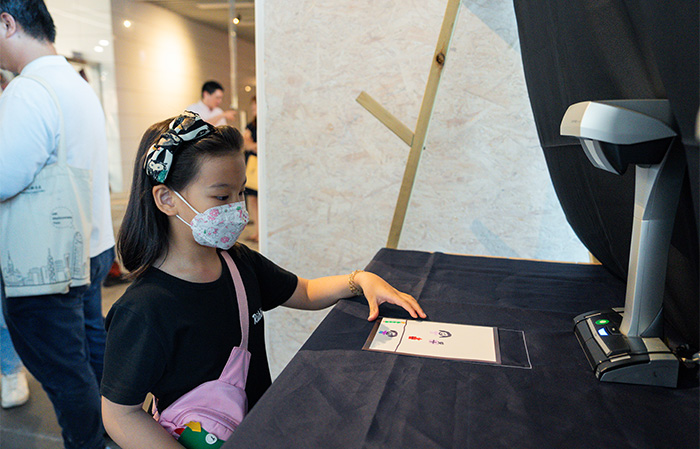
For example, in the lower right corner of the work, there is a group of fish and shrimp elves holding treasures in their hands. The fins of the fish elves in the painting are transformed into hands, which can not only carry plates, but also coral. This is the imaginative power of the artist who, according to religious rituals, visualized the gods, ghosts, elves and monsters that he had heard of but had not yet seen, and created this wondrous work of art with his rich and vivid imagination. Through the appreciation of the paintings and the interpretation of modern technology, it is possible to re-create an extraordinary world of gods, ghosts, spirits, and monsters in a myriad of variations.
Theme-based performance reenacting the parade of gods and ghosts
The opening performance of the opening ceremony was also very appropriate, inviting the outstanding performing arts team of Taichung City to create a customized theme-based opening performance, presenting a multi-layered style of the San guan' beliefs and interpreting the spirit of respecting heaven and thanking the earth. The opening performance kicked off with a solemn and sacred General of Heaven commanding the San guan, followed by a dance performance by the fairies to convey joy and blessings, and finally a dance performance to reenact the Heavenly Officials, Earth Officials, and Water Officials on their rounds with all the deities and ghosts, presenting the graphic portraits in a vivid and dynamic way.
NLPI hopes that the exhibition will help the public understand more about the San guan culture and beliefs. The reading seminar also invited Prof. Feng Mao Li, a renowned Taiwan religious scholar, Academia Sinica's Academician, who also holds the dual status of scholar and certified Taoist priest, to share his views.
Feng Mao Li elaborated on the close relationship between the San guan faith and Taiwan's local society, not only as the guardian temple of many settlements, but also as the center of faith in many communities to this day. He also summarized the spirit of the San guan faith from ancient texts, so that the audience would have a better understanding of how the San guan faith affects the customs and culture of daily life.
At the same time, we will analyze the delicate brushwork and aesthetics of“ The Three Taoist Officials Making an Inspection Tour”, and appreciate this work of art from a different perspective, which also adds to the mysterious beauty of Oriental culture to this exhibition.
